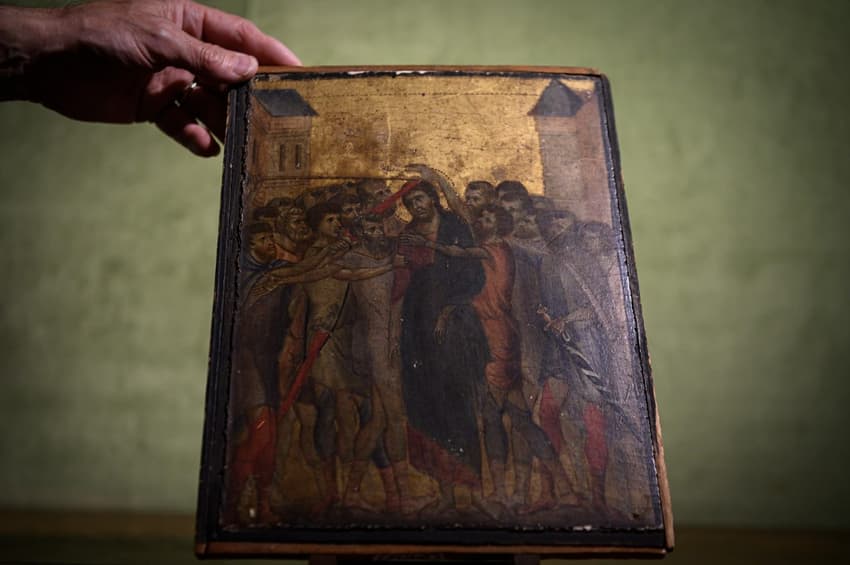Old French lady discovers Italian Renaissance masterpiece in her kitchen

An early Renaissance masterpiece by the Florentine master Cimabue has been discovered in an old lady's kitchen in a town near Paris, art experts said on Monday.
'Christ Mocked', by the 13th-century artist who taught Giotto, is estimated to be worth between 4 and 6 million euros, according to the Old Masters specialists Turquin.
They said the work was owned by an old lady in the northern French town of Compiegne, who had it hanging between her kitchen and her sitting room. It was directly above a hotplate for cooking food.
READ ALSO:
-
In the footsteps of genius: A travel guide to Leonardo Da Vinci's Italy
-
Caravaggio's 'lost masterpiece' snapped up by unnamed buyer
-
Mystery of 'Salvator Mundi', the world's most costly painting
The painting is thought to be part of a large diptych dating from 1280 when Cimabue painted eight scenes depicting Christ's passion and crucifixion. Two other scenes from the work hang in the National Gallery in London -- 'The Virgin and Child with Two Angels' -- and the Frick Collection in New York ('The Flagellation of Christ').
The scene in the National Gallery was also lost for centuries, and only found when a British aristocrat was clearing his ancestral seat in Suffolk. It was given to the nation in 2000.

'The Virgin and Child with Two Angels' by Cimabue, now in the National Gallery in London.
The French painting's elderly owner thought it was just a rather old religious icon when she took it to her local auctioneers to be valued.
Early Renaissance art was hugely influenced by Byzantine art, which is still produced in a similar style today on a background of gold paint.
Tests using infrared light found that there was "no disputing that the painting was done by the same hand" as other known works by Cimabue, said art expert Eric Turquin.
It will now go under the hammer at the Acteon auction house in Senlis, north of Paris, on October 27th.
Comments
See Also
'Christ Mocked', by the 13th-century artist who taught Giotto, is estimated to be worth between 4 and 6 million euros, according to the Old Masters specialists Turquin.
They said the work was owned by an old lady in the northern French town of Compiegne, who had it hanging between her kitchen and her sitting room. It was directly above a hotplate for cooking food.
READ ALSO:
- In the footsteps of genius: A travel guide to Leonardo Da Vinci's Italy
- Caravaggio's 'lost masterpiece' snapped up by unnamed buyer
- Mystery of 'Salvator Mundi', the world's most costly painting
The painting is thought to be part of a large diptych dating from 1280 when Cimabue painted eight scenes depicting Christ's passion and crucifixion. Two other scenes from the work hang in the National Gallery in London -- 'The Virgin and Child with Two Angels' -- and the Frick Collection in New York ('The Flagellation of Christ').
The scene in the National Gallery was also lost for centuries, and only found when a British aristocrat was clearing his ancestral seat in Suffolk. It was given to the nation in 2000.

'The Virgin and Child with Two Angels' by Cimabue, now in the National Gallery in London.
The French painting's elderly owner thought it was just a rather old religious icon when she took it to her local auctioneers to be valued.
Early Renaissance art was hugely influenced by Byzantine art, which is still produced in a similar style today on a background of gold paint.
Tests using infrared light found that there was "no disputing that the painting was done by the same hand" as other known works by Cimabue, said art expert Eric Turquin.
It will now go under the hammer at the Acteon auction house in Senlis, north of Paris, on October 27th.
Join the conversation in our comments section below. Share your own views and experience and if you have a question or suggestion for our journalists then email us at [email protected].
Please keep comments civil, constructive and on topic – and make sure to read our terms of use before getting involved.
Please log in here to leave a comment.